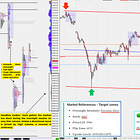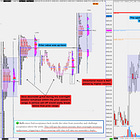Hey team. Last week saw a slew of economic reports and market catalysts spike market volatility, and as we head into the next week, inflationary reports are set to keep the same theme going.
Today’s article highlights an important skill that most traders lack: intuition.
Impact Snapshot
Fed Powell Testimony - Tuesday/Wednesday
U.S. CPI Inflation - Wednesday
U.S. PPI Inflation - Thursday
Unemployment Claims - Thursday
Retail Sales - Friday
Macro Viewpoint
The S&P 500 index started February with a 0.2% decline for the week, following January job gains that fell slightly short of expectations and a dip in US consumer sentiment to its lowest level since July.
Last week, DeepSeek grabbed financial attention. More crucial for markets were the questions it raised about major investments in data centers, chip procurement, and energy expansion—key drivers of this entire rally.
Despite a 1.5% drop in the S&P 500 last Monday, the losses could have been more severe given the market's heavy reliance on Tech.
On Friday, government data revealed that US job growth in January was weaker than anticipated.
Additional reports indicated that consumer sentiment had dropped to a six-month low, while year-ahead inflation expectations climbed to their highest level since November 2023.
Looking ahead, the focus will shift from employment to inflation data. The January Consumer Price Index will be released on Wednesday, followed by the Producer Price Index on Thursday. Chairman Powell also makes his semi-annual trek to Congress on Tuesday and Wednesday.
Working on Your Intuition
You’re a fairly new driver, and you’ve just bought a house with a garage. The first time you try to park your car in that garage, you proceed cautiously. You move slowly, constantly check your rearview mirror, and carefully monitor the positioning of your steering wheel as you back in. It’s a meticulous process, and it might take you 10 minutes to finally park the car just right.
After several weeks, this process is now embedded into your intuition. What once required intense focus and active thought now feels almost effortless. Parking your car in the garage becomes second nature, taking just a minute or so.
You no longer need to consciously calculate how many turns of the steering wheel are needed or overthink your movements. Instead, your intuition takes over, guiding you seamlessly through the process.
Trading is very much like that. Without an intuitive grasp of the markets, successfully executing short-term trading strategies becomes challenging.
Every morning before trading, you should evaluate market conditions using the same data points—effortlessly, without overthinking. Key questions to ask include:
Is overnight inventory too short or too long, suggesting a potential correction?
Who is likely in control of the overnight action, and how confident is the market?
Where is price relative to the last value area?
Where is the settle?
Are we opening with a gap?
Are there any anticipated catalysts for the session?
Is the market in balance or imbalance?
Where are the previous session’s highs and lows?
When you’re looking at the whole picture it’s like putting a puzzle together. When you look at the puzzle, it’s a holistic view of the market. There is a great deal of art involved in trading, it’s not just a science.
An experienced driver doesn’t need to consciously think through every step of parking a car. Similarly, an experienced trader doesn’t need to overanalyse every market nuance.
When you first start trading, it’s essential to carefully and consciously assess these factors before acting—until they become second nature.
Intuition allows traders to identify emerging trends before they appear on charts or in data. It’s the ability to perceive subtle signals that hint at market direction, providing an edge in capitalising on trends early.
However, intuition must be consciously developed through experience. Without deliberate practice, intuition can work against you.
Good intuition is earned through repetition, observation, and time in the markets.
We highly recommend checking out two of our deep-dive prior sessions which we shared on the Free Substack version last week to see how we monitor these exact nuances and mention them hours before the fact after developing a solid intuition.
Develop better context and create a robust entry model by understanding all the market nuances we share on a daily basis. This will help you build the market understanding that most traders lack.




